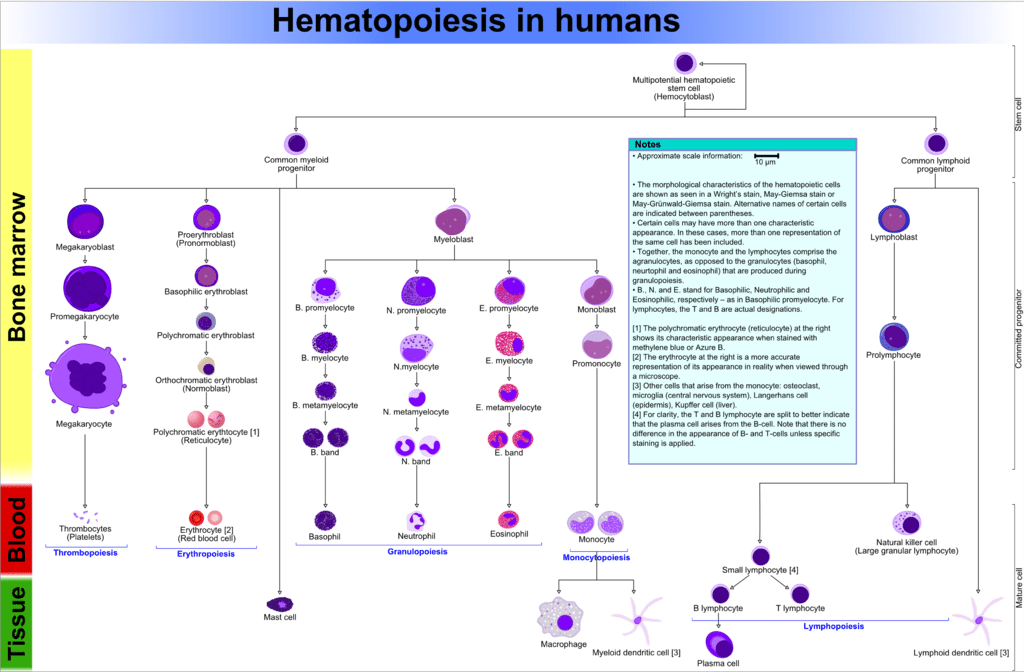The key difference between mature and immature lymphocytes is that the mature lymphocytes have the ability to fight against infections in the body, while the immature lymphocytes do not have the ability to fight against infections in the body.
A lymphocyte is a type of white blood cell that is a part of the immune system. Based on their function, there are three main types of lymphocytes: B cells, T cells, and natural killer cells. B cells produce antibodies to attack invading bacteria, viruses, and toxins. T cells destroy body’s own cells that have been taken over by viruses or become cancerous in nature. Natural killer cells function in cell-mediated cytotoxic innate immunity. However, based on their maturation, lymphocytes are categorized into two types as mature and immature lymphocytes. Immature lymphocytes are precursors to mature lymphocytes.
CONTENTS
1. Overview and Key Difference
2. What are Mature Lymphocytes
3. What are Immature Lymphocytes
4. Similarities – Mature and Immature Lymphocytes
5. Mature vs Immature Lymphocytes in Tabular Form
6. Summary – Mature vs Immature Lymphocytes
What are Mature Lymphocytes?
Mature lymphocytes have the ability to fight against infections in the body. Mature lymphocytes are white blood cells that travel through the lymphatic system and help humans and other animals fight against numerous diseases. There are three main lymphocytes, including B cells, T cells, and natural killer cells. All these cells originate from the bone marrow. But some travel to different areas of the body to mature. They also perform different functions. However, these lymphocytes generally attack invasive cells and tissue.

Figure 01: Mature Lymphocytes
B cells develop in the bone marrow and mature there as well. Mature B cells then constantly travel throughout the body. When they detect an invader in the body, B cells turn to plasma cells that produce antibodies. This is called a humoral response. T cells are developed by stem cells in the bone marrow. Then they travel to the thymus gland, where they mature completely. Later these T cells travel to lymph nodes, where they are transferred to the bloodstream if necessary. The majority of T cells are extremely small, but a handful of these cells grows to about twice the size of the rest. All mature T cells take care of cell-mediated adaptive immunity.
Initially, it was thought the natural killer cells were developed exclusively in the bone marrow. But recent studies suggest they also can develop and mature in secondary lymphoid tissues (SLTs), including tonsils, spleen, and lymph nodes. Natural killer cells are the predominant innate lymphocyte subsets that normally mediate anti-tumor and anti-viral responses.
What are Immature Lymphocytes?
Immature lymphocytes do not have the ability to fight against infection in the body. They predominantly originate from the stem cells of the bone marrow. They can also refer to immature cells that typically differentiate to form mature lymphocytes.

Figure 02: Hematopoiesis
Immature lymphocytes are activated by antigens from antigen-presenting cells and increased in volume by the nucleus and cytoplasm growth, as well as new mRNA and protein synthesis. They start dividing two to four times every 24 hours for three to five days, where a single immature lymphocyte makes approximately 1000 clones of its original naive lymphocyte. Finally, the dividing cells differentiate into effector cells (mature lymphocytes) known as plasma cells (B cells), cytotoxic T cells, T helper cells, and mature natural killer cells.
What are the Similarities Between Mature and Immature Lymphocytes?
- Mature and immature lymphocytes are two types of lymphocytes based on maturation.
- Immature lymphocytes are precursors to mature lymphocytes.
- Both types can be found in the bone marrow.
- They can be converted to cancer cells.
What is the Difference Between Mature and Immature Lymphocytes?
Mature lymphocytes have the ability to fight against infection in the body, while immature lymphocytes lack the ability to fight against infection in the body. Thus, this is the key difference between mature and immature lymphocytes. Furthermore, mature lymphocytes are found in bone marrow, thymus, lymph nodes, bloodstream, tonsils, and spleen. On the other hand, immature lymphocytes are predominantly found in the bone marrow and rarely secondary lymphoid tissues (SLTs).
The below infographic presents the differences between mature and immature lymphocytes in tabular form for side by side comparison.
Summary – Mature vs Immature Lymphocytes
Mature and immature lymphocytes are two types of lymphocytes based on maturation. Mature lymphocytes have the ability to fight against infection in the body, while immature lymphocytes do not have the ability to fight against infection in the body. So, this is the key difference between mature and immature lymphocytes.
Reference:
1. “What Are Mature Lymphocytes?” Wise Geek.
2. “Lymphoblast.” Encyclopædia Britannica, Encyclopædia Britannica, Inc.
Image Courtesy:
1. “Plasma cells” By Department of Pathology, Calicut Medical College – Calicut Medical College (CC BY-SA 4.0) via Commons Wikimedia
2. “Hematopoiesis (human) diagram” By A. Rad – Own work (CC BY-SA 3.0) via Commons Wikimedia
ncG1vNJzZmivp6x7pbXFn5yrnZ6YsqOx07CcnqZemLyue9ahmK1lmah6tbTEZpuinpaav6a6wp5km52krLKmuoymmK2topp6orrDZqCmpZGpwrOxjKWwpqiYpLC6wMSsZg%3D%3D